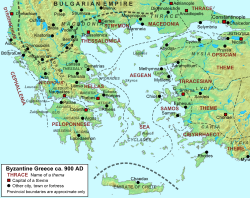Peloponnese (theme)
| Theme of the Peloponnese Πελοπόννησος, θέμα Πελοποννήσου |
|||||
| Theme of the Byzantine Empire | |||||
|
|||||
| Map of Byzantine Greece ca. 900 AD, with the themes and major settlements. | |||||
| Capital | Corinth | ||||
| Historical era | Middle Ages | ||||
| • | Established | ca. 800 | |||
| • | Conquered by Crusaders. | 1205 | |||
| Today part of |
|
||||
The Theme of the Peloponnese (Greek: θέμα Πελοποννήσου) was a Byzantine military-civilian province (thema, theme) encompassing the Peloponnese peninsula in southern Greece. It was established in c. 800, and its capital was Corinth.
From 27 BC until the end of the 6th century, the Peloponnese formed part of the province of Achaea, which during Late Antiquity comprised also the eastern parts of Central Greece. Its capital was Corinth.
From the 580s on, as attested in the Chronicle of Monemvasia, the Slavic invasions which affected the wider Balkans reached the peninsula, and led to the abandonment of the urban centres of Antiquity in favour of either remote or offshore locations like Monemvasia, while the inhabitants of several cities such as Patras are claimed by the Chronicle to have emigrated to Italy altogether. Along with statements by medieval chroniclers like Isidore of Seville and Constantine Porphyrogennetos that Greece had completely submitted to the Slavs, this led to assumptions by earlier scholars that collapse of Byzantine control was total, and that the Peloponnese remained outside imperial control for two centuries afterwards. The literary evidence is partially confirmed by several buried coin hoards from the 570s/580s and early 7th century, which attest to large-scale upheaval in two waves, one that peaked ca. 587, the date provided by the Chronicle, and one that peaked in the far larger crisis of the reign of Heraclius (r. 610–641). Literary, toponymic and archaeological evidence on the other hand shows that the Slavic invaders settled mostly in the western half of the peninsula, i.e. the fertile plains of Elis and Messenia, Achaea and the plateau of Arcadia, while Byzantine authority survived in the more mountainous eastern parts of the peninsula as well as in various outposts around the coast, including Patras. Nevertheless, as the rapid-re-Hellenization of the peninsula in the 9th century shows, a large Greek-speaking population must have remained in the areas overrun by the Slavs.
...
Wikipedia

